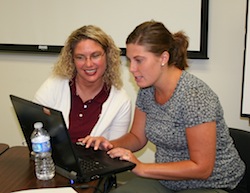Co-Teaching Harmony: Part 2
A MiddleWeb Blog
Creating co-teaching harmony takes an ongoing commitment throughout the year. It takes perseverance. It takes an “I’m all-in” mindset that positively prevails throughout all thick and thin co-teaching situations.
At the beginning of the year, we have the gift of time. We have a chance at a fresh start. This chance only comes once each year. Embrace this new beginning—think about your ideal co-teaching experience, and then begin to fashion an action plan to blend your ideal with your reality.
I place our co-teaching decisions into two categories. In my last post I focused on creating positive relationships (check out the link here). This week’s post will focus on paving the way for effective instructional and assessment practices that will help students achieve in inclusive settings.
Real learning for every student
The premise behind inclusion is to educate all students in the general education setting. We must meet the needs of learners, while not segregating or isolating anyone from the natural learning experiences that occur in everyday classroom settings. Yet there is much to consider to ensure that real learning happens for every student.
Many decisions need to be made that go far beyond just giving students a place to sit in the room. We must remove all instructional and environmental barriers. The two teachers in the room must be on the same page, so that the needs of all learners are met.

How will we organize the curriculum?
• Consider standards, content, and learning outcomes.
• Identify essential understandings and skills to be learned.
• Identify each co-teacher’s strength and interest as it connects to the content.
How will we specialize instruction to meet the needs of all learners?
• Review students’ individualized education plan (IEP) and plan options of instruction and delivery.
• Understand that ALL students in the room are individuals who will benefit from a variety of instructional and assessment approaches.
• Incorporate flexible grouping.
• Plan for learner variability—offer multiple means of representation, engagement, and expression through implementing the principles of universal design for learning. (For more information on UDL, see the CAST website and the National Center for Universal Design for Learning). You can also check out the archives of my posts on the topic of UDL.
How will we accommodate for student’s individual education plan (IEP) goals?
• Keep a list of students’ IEP goals in your planbook for easy reference as you co-plan and prepare and evaluate your lessons.
• Identify and insert strategies that will guide students toward independent learning.
How will we engage and monitor student progress throughout the learning process?
• Provide multiple means of engagement and expression through a universal design for learning mindset.
• Encourage executive functioning skills and student ownership.
• Have students create rubrics and set standards for learning with you.
• Make outcomes visible, so students may generate realistic learning goals based on their personal performance.
• Incorporate formative assessments that inform your instruction and motivate students to stay on the path to mastery. It’s not all about the numbers we get from summative assessments.
Tips for a smooth co-teaching start
Here are some tips to help you to get the year off to a smooth start:
For starters, let’s begin the year by discussing the models of co-teaching. Make sure you shake it up as you co-teach. Plan ahead and also remember to teach in the moments. Do not get stuck in the rut of “One teach and One Assist.” There are many effective models of co-teaching to choose from, so why get caught on a status quo treadmill? Step out of your comfort zone, and make sure to keep your co-teaching communication open. Talk it out! Plan it through! Shake it up! Find your co-teaching balance.
2. Stay Organized
Here’s a fact: when I am organized, I am a better teacher. I model good organization for students, and I am also able to keep track of my many students, co-teachers, content areas, assignments, and responsibilities. Our planbook is one of the main tools to organize. This year I am using planbookedu—an online planbook that provides many optional and helpful features. Check it out—it might be for you, too!
3. Set Up the Physical Space
Make sure that you and your co-teaching partner have a clear space to call your own. Arrange the desks in a way that promotes flexible instructional grouping and provides for a smooth flow of mobility. Make sure you have easy access to all tools, bulletin boards, dry-erase boards, etc., that you will need.
4. Devise a Co-Decisionmaking Process
Making decisions throughout the year is a vital role of all teachers. When co-teaching, we must make sure to combine our decisions, while we share our thinking along the way. Keep in mind that the two teachers in the room will not agree on everything, but we will continue to respect and value the perspective of one another. Be firm when you need to be, but stay flexible. And always remember to base decisions on data—not emotions.
It is a professional necessity to wrap our minds around what our students need. Yet we must remember to take care of ourselves, too. We have to take care of our professional side by building our personal learning networks, attending workshops, presenting our ideas at faculty meetings, and collaborating with colleagues. And we have to take care of our personal selves. We must make sure to eat right, exercise, get enough rest.
We all know this, but it’s easy to slip. In order to give our students all we’ve got, we must make sure to keep our personal and professional selves in check—it is the only way to create personal and professional harmony to achieve goals and guide learners to master the learning process.
SO: How are you using your once-a-year fresh start to create co-teaching harmony? Let’s talk!
**Be sure to check out my new co-teaching chat on Twitter—using #coteachat. Chats are the second and fourth Tuesday of each month. Next chat: August 27 from 8:00-8:45 EDT. This week’s topic is embedding the models of co-teaching with the Common Core. See you there!**






































Do you have any thoughts on how to respond /communicate to parents of high performing GE students who will be enrolled in an Inclusion class with special needs students for the first time ?
Hi, John,
This is such an important variable to think about. It is another aspect I hold near and dear to me. Thanks for bringing it up!
As you know, it is very common for parents to be hesitant (and some very resistant) to having their children placed in an inclusion setting. This hesitancy can be redirected by informing parents about what inclusion really is. Redirecting myths and keeping communication open. Once parents realize that inclusion is a class that requires the same high standards and challenges as any other classroom. It is a class with two qualified teachers who can focus on product and process as a powerful team. We need to send positive messages to parents, and act on these positive messages as a school and as a district community. We will then begin to re-channel such unnecessary stigmas that labels bring–at least we can do our share to make a difference.
So, back to your question…”how” to do this…here are some of my off the top ideas:
I think:
-we first have to make sure our inclusion programs are solidly in place with best practices, and
that our teachers are on board.
-make sure there is ongoing support and PD for teachers
-we should present to parents–at PTA meetings, for example.
-both teachers should communicate as appropriate with all parents throughout the year
I will be dedicating an upcoming post to this important topic in the near future, so that I will give it the attention and detail it deserves.
Thanks so much for sparking this meaningful discussion. I would love to hear your thoughts. Have I responded to your question sufficiently–at this point? What are your experiences?
All the best!
Elizabeth and John, This is an interesting question and one that is also near and dear to me. Your point about dispelling myths about inclusion and meeting the needs of all seems to be a good place to start. Secondly, the most consistent findings from neuroscience suggest that all students vary. It is the norm and not the exception. So, not only is having two teachers a bonus, being educated in a room where the teacher is proactively teaching to address variability in all its myriad forms can be seen as a strength that will benefit all students. Just some random thoughts. Love this blog!
Yvonne, your comment reminds us that a universal design for learning mindset can be the ultimate solution as we look to break down barriers in the environment, curriculum, and certainly perspectives of parents, students, educators, etc….
I am using the language of variability in all discussions with colleagues and parents. It does send such powerful proactive messages of belonging, acceptance, and achievements!
Thanks so much for your thoughtful comment. Keep reading and please keep commenting!
I’m looking for ideas and blueprints on how to set up an elementary co-teaching classroom. Do you have any suggestions on where I could find these?